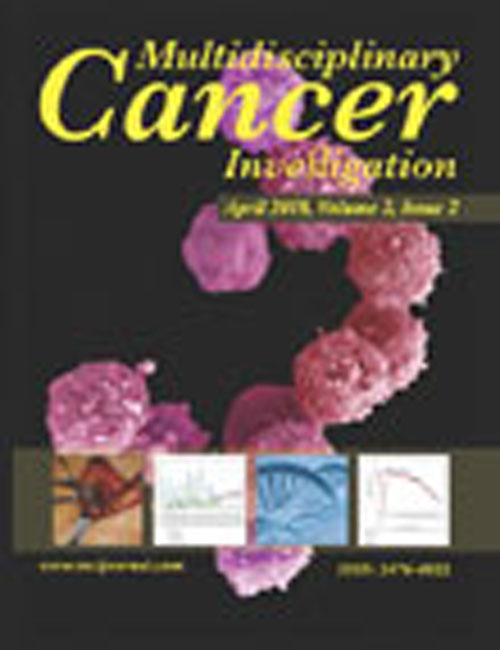فهرست مطالب

Multidisciplinary Cancer Investigation
Volume:2 Issue: 1, Jan 2018
- تاریخ انتشار: 1397/01/30
- تعداد عناوین: 4
-
-
Pages 1-12Impairments in cell migration processes may cause various diseases, among which cancer cell metastasis, tumor angiogenesis, and the disability of immune cells to infiltrate into tumors are prominent ones. Mathematical modeling has been widely used to analyze the cell migration process. Cell migration is a complicated process and requires statistical methods such as random walk for proper analysis. In this study, we reviewed the studies conducted on the random walk-based stochastic modeling of the eukaryotic cell migration. This statistical modeling can open some perspectives on more detailed modeling approaches and ultimately lead to more comprehensive knowledge about the biophysical and biochemical foundations of cell migration process.Keywords: Cell Migration, Random walk, Cancer
-
Pages 13-21IntroductionIron oxide nanoparticles, owing to their very small size and superparamagnetic properties, have been considered a potential candidate for several medical applications such as magnetic cell separation, magnetic resonance imaging (MRI), magnetic targeted drug delivery magnetichyperthermia. The present study aimed to synthesize and evaluate the characteristics of superparamagnetic iron oxide nanoparticles (SPIONs) and determine the mechanism by which they induce cell death in the presence of an extremely low-frequency magnetic field (ELMF).MethodsFirst, SPIONs were synthesized using the chemical co-precipitation method and then characterized by X-ray diffraction (XRD), transmission electron microscopy (TEM), dynamic light scattering (DLS), and zeta potential. A vibrating-sample magnetometer (VSM) was used to measure the magnetic properties of the nanoparticles. Human MCF-7 breast cancer cells were treated with different concentrations of SPION in the absence and presence of a 50-Hz ELMF for 24 and 48 h. Cytotoxicity and cell viability percentage in the treated cells were measured by the MTT (3-(4,5-di-methylthiazol-2-yl)-2,5-diphenyltetrazolium bromide) assay.ResultsDLS and TEM analyses indicated that the SPIONs have an average size of less than 30 nm and they are superparamagnetic. VSM analyses also confirmed the superparamagnetic nature of the nanoparticles. The MTT assay indicated that high concentrations of SPIONs induced death in MCF-7 cells. In the groups treated with ELMF䣲ึ, cell death increased sharply compared with that in the groups treated with each treatment alone (P≤0.05).ConclusionsIt seems that a 50-Hz ELMF in the presence of SPIONs led to cell death due to local heating.Keywords: Superparamagnetic Iron Oxide, Extremely Low, Frequency Magnetic Fields (ELMFs), X-ray Diffraction
-
Pages 22-25IntroductionMultiple myeloma is a heterogeneous disease with different survival times among patients. Accurate prediction of prognosis in multiple myeloma is essential, as patients with a shorter survival time may require early bone marrow transplantation (BMT) and more advanced chemotherapy as a part of their first-line treatment. In the present study, a parameter, depicted by gamma (γ) symbol, was utilized to categorize patients into different stages. Gamma value is equal to the summation of each prognostic factor multiplied by its corresponding beta coefficient. This parameter has been previously studied for the staging of some malignancies, such as Nottingham Prognostic Index for breast cancer and Prognostic Score for parotid carcinoma.MethodsOne hundred forty-three cases were randomly divided into two groups. Beta coefficients for prognostic factors, including creatinine, calcium, and albumin, were obtained from multivariate Cox analysis in the first group. In this group, a staging system based on patients gamma parameters was defined followed by the evaluation of the accuracy of this staging system in the second group.ResultsThe staging system that developed from the first group was suitable for the prediction of outcomes in the second group. The patients of the second group were divided into approximately equal numbers in each stage comprising 29, 24, and 18 cases in stage 1, 2, and 3, respectively. In this group, the median overall survival (OS) values for patients in each stage were 92, 57, and 22 months, respectively, with log-rank = 0.002.ConclusionsThe proposed method demonstrated promising results for myeloma prognostication. The authors believe this approach would increase the strength and validity of staging of multiple myeloma.Keywords: Multiple Myeloma, Staging, Prognostic Factors
-
Pages 26-32IntroductionThere is a lack of information on the extent of dependency between chronic diseases and the survival rate of breast cancer. Until date, none of the models proposed has determined the impact of chronic diseases on breast cancer survival. This study, therefore, aimed to investigate the impacts of chronic diseases such as diabetes, blood pressure, and endocrine disorders on the survival of breast cancer patients through a comprehensive research.MethodsAll (n = 1822) breast cancer patients treated in the three hospitals of Tehran from 2007 through mid2016 were included in this study. A comprehensive study was conducted by focusing on the chronic disease data of the studied patients. The parametric and semi-parametric approaches, as well as non-parametric Kaplan-Meier analysis, were performed. This research proposes two models for analyzing breast cancer survival. A comparative analysis of the models was performed based on the Akaike criterion.ResultsChronic diseases have been found to affect the survival of breast cancer patients. This research considered 436 individuals, among the patients with chronic diseases including hypertension, diabetes, hypo- and hyperthyroidism, and heart problems at the frequencies of 12.38%, 11.69%, 8.71%, and 8.02%, respectively. This study indicated that the 5-year survival of breast cancer patients with chronic diseases was 72% and that it was 82% for other breast cancer patients. The statistical analysis and the two proposed models revealed that chronic diseases significantly affect the survival of the study patients.ConclusionsThis comprehensive research evidence a significant difference in the survival rate of breast cancer patients with and without chronic diseases. The statistical analysis of the data indicated that chronic diseases can significantly affect the survival probability in breast cancer. Heart problems and the combination of chronic diseases have a major influence on the survival rate of breast cancer patients as compared to other cases.Keywords: Breast Cancer, Chronic Diseases, Survival Analysis

